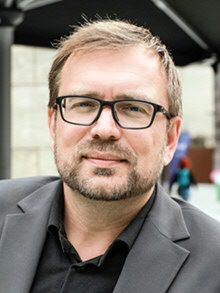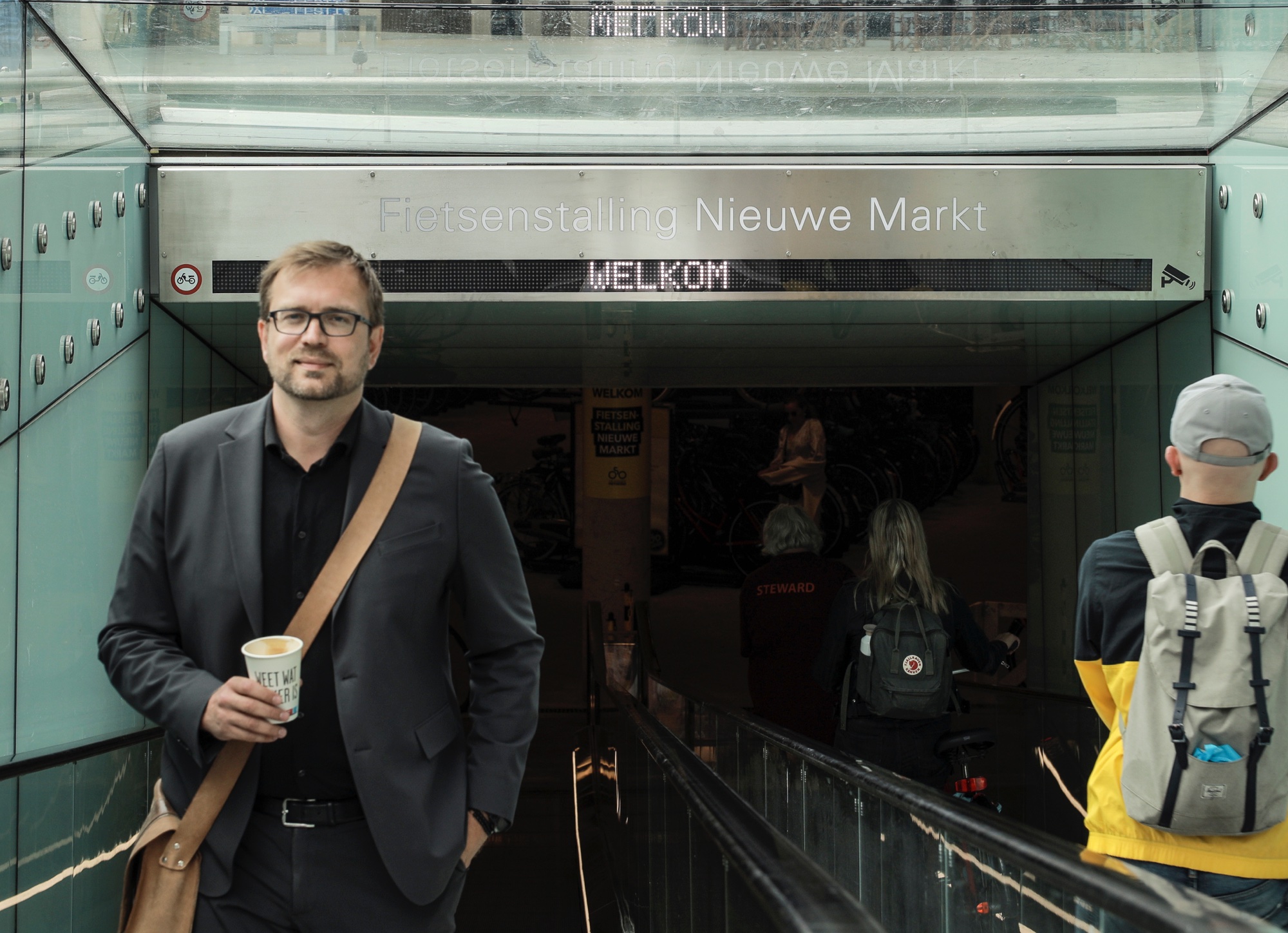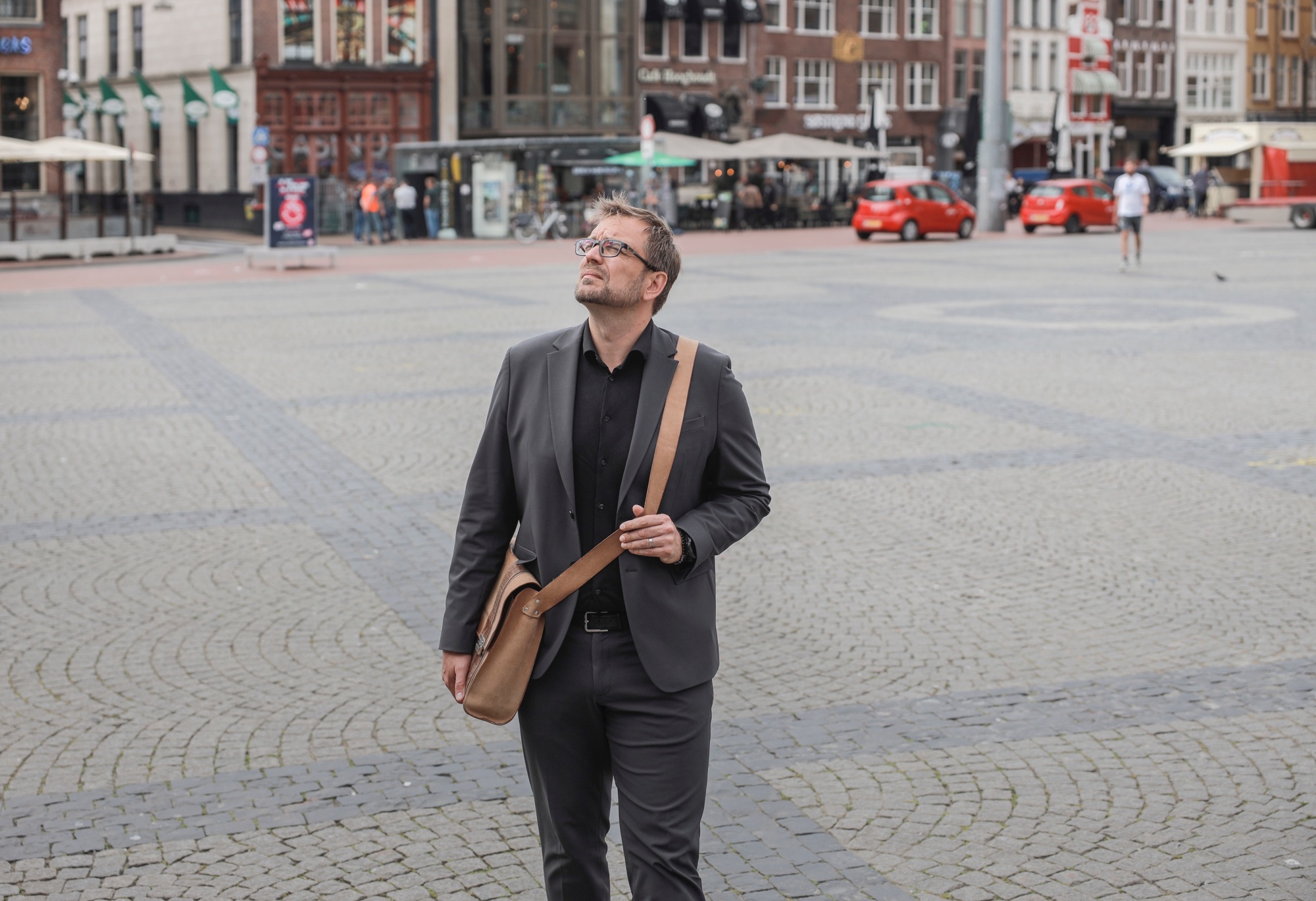The vulnerability of the ‘cappuccino city’

Deserted city centres, drained of all life by COVID-19 and lockdowns. Urban geographer Martin Boisen wrote a blog post about it in the middle of the second wave of the pandemic. A tragic, even melancholy image, that he believes should give us pause: ‘How can it be that some city centres are so deserted when there are no visitors? Tourism promotes liveliness, but it also has the power to quell all other forms of liveliness.’ How did this happen? And can we still turn the tide?
Text Martin Althof / Photos Henk Veenstra
Only a few years after his graduation and a short spell as junior lecturer at Utrecht University, Boisen (Copenhagen, 1981) became director of a consultancy firm. But he continued to hanker after teaching, and in 2013, he accepted a teaching position at the UG. In his lectures, he explains how cities work and how they have developed and continue to develop. ‘Teaching produces a direct and meaningful result: I teach my students to think carefully and to do something with their knowledge.’ Alongside his work as lecturer, he often meets with governments and policymakers in the hope that his insights can help improve our cities and regions. With his consultancy firm, For the Love of Place, he has been involved in over one hundred consulting projects so far, for cities and regions in the Netherlands and abroad.
Restaurants and cafés to replace shops
Boisen explains animatedly how the status and function of city centres is constantly changing. ‘In our part of the world, after World War II, we tried to rebuild the partially or completely destroyed cities and bring them back to life. This was followed by a process of suburbanization, with people living outside the city with a supermarket or shopping centre nearby. But many shops remained in the city centre, and the apartments above them were turned into storage space. New cities, such as Zoetermeer, were even built on the principle of a shopping centre surrounded by residential districts. Later on came digitization, and many physical shops struggled to survive. This freed up a lot of square metres in city centres, which were taken over by restaurants and cafés.’ According to Boisen, what makes historical city centres unique is that in terms of real estate, they are not designed for a single function. They are therefore more flexible, and can more easily move with the times.
Everything focuses on consumption
According to Boisen, what is typical of Dutch city centres in the 21st century is that nearly all public spaces are radically commercialized. ‘Public spaces have become places where you can only sit with a cappuccino, latte macchiato, or beer. Anything, really, as long as it involves you pulling out your wallet. There is little room for spontaneous meetings, playing children, or simply “being”. Incidentally, this a tendency we see in all compact European city centres: a transition to consumption landscapes.’ Boisen notes that this movement is expanding to districts around the city centre. ‘Here too, “non-consumption-driven life” is being crowded out—sometimes as a conscious or unconscious side-effect of urban innovation and gentrification. Where can you still sit quietly in the sunshine with your homemade sandwich and can of beer? And even if you do, you will soon feel out of place. You won’t feel really comfortable, because you’re deviating from the norm.’

City trips and holidays
Boisen lists a number of reasons for this shift from a mixed landscape to a consumption landscape. ‘First of all, we have simply all become richer. Even young people can now afford things that used to be impossible. Think of popular city trips: three days to Barcelona or Rome. This is also partially a cultural phenomenon: in the Netherlands, a growing number of people consider a summer holiday, a winter sport holiday, and a couple of city trips in between to be almost self-evident.’ Add to this the fact that for the past twenty years, city centres have been managed from a neo-liberal, primarily economic perspective. ‘The most important thing is more visitors, more overnight stays, more shoppers, more purchases, and more jobs. The focus lies primarily on attracting people who are not there yet—and less on the people who live or simply “are” there, without necessarily opening their wallet.’
Power of tourism
These developments are creating an enormous traction power in one direction. In this context, Boisen distinguishes three categories of European cities. First, there are cities like Amsterdam, Venice, and Berlin, which are overrun by tourists, expats, and local and international students. Then there is the category that includes Groningen, Ghent, and Utrecht, which is steadily heading in the same direction. And finally, there are cities that do not yet attract so many tourists, places like Arhus, Goteborg, and Poznan. Boisen: ‘The debate in the first category feeds the discussion in the second category. For example, in recent years, we have seen in Amsterdam that there is a movement to reinstate regulation, but that the power of the economic interests linked to tourism is very strong. Changing this now requires stringent measures, some of them at a national rather than local level. Cities like Groningen and Ghent should learn from these experiences. In terms of tourism, these cities are not yet entirely out of balance, although I believe they are already off-balance when it comes to student numbers. We must avoid becoming too dependent on a single activity: what you want is a more diverse city centre economy. But this is not a popular story, because it runs against vested interests. For the third category of city, there is still much to be gained via tourism, as long as this is well managed.’

An empty city
And then, one day, the pandemic hit. The leisure economy ground to a halt, all catering businesses closed down. An empty city. Boisen: ‘Suddenly, we became aware of how big our city squares are! And where could we actually sit in our own city centres? All “cappuccino chairs” had disappeared. Stacked on top of one another, and chained to the closed restaurants and cafés. Catering staff went in search of new jobs, some of them never to return. Shop-owners were largely kept afloat, but I fear that most of the blows are still to come for this group. What is left of our city centres?’
More than a revenue model
In this way, the pandemic actually made it even clearer that a city is—and should be—a lot more than an attractive consumption landscape, more than a revenue model. ‘We must adjust our perspective on cities and city centres. For too long, we have looked at the city as a machine to be managed. But cities and city centres bring together the entire spectrum of human activity. A city should offer physical and mental space for everyone. Solutions for the problems facing cities will have to be tailored to individual cases and take into account specific local circumstances, including the local and regional community itself.’ According to Boisen, this requires visionary management and a renewed solidarity. ‘Coalitions of citizens and entrepreneurs should be given space to work towards real solutions, with politicians daring to take the lead, and not just following or running for cover. We have to once again dare to fail. Simply because not trying it is not an option!’
| Last modified: | 23 June 2022 4.03 p.m. |
More news
-
09 October 2025
Open colleges bij de Faculteit Ruimtelijke Wetenschappen
Heb je een baan in ruimtelijke ordening, planologie, geografie of aanverwante vakgebieden, is kennis op deze gebieden zinvol voor je werkzaamheden en specialisatie of ben je op zoek naar verdieping op een bepaald onderwerp? Dat kan! De Faculteit...
-
30 September 2025
Politiek zet z'n tanden in de verdeling van schaarse ruimte in Nederland
Op de avond van 29 september 2025 staat het Groninger Forum in het teken van het Nationaal Ruimtelijk Verkiezingsdebat. In aanloop naar de verkiezingen gaan kandidaat-kamerleden in debat over de toekomst van ruimtelijk Nederland. Hoe verdelen we de...
-
23 September 2025
6e Editie van het Nationaal Ruimtelijk Verkiezingsdebat in Groningen
Wonen. Landbouw. Klimaat. Allemaal willen ze hun plek in Nederland. Dat vraagt om keuzes, waar komt wat en wie bepaalt dat? Hoe houden we Nederland leefbaar voor de volgende generaties? Dat is waar het Nationaal Ruimtelijk Verkiezingsdebat om...
